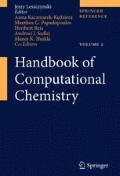Abstract
Methods of computational chemistry seem to often be simply a melange of undecipherable acronyms. Frequently, the ability to characterize methods with respect to their quality and applied approximations or to ascribe the proper methodology to the physicochemical property of interest is sufficient to perform research. However, it is worth knowing the fundamental ideas underlying the computational techniques so that one may exploit the approximations intentionally and efficiently. This chapter is an introduction to quantum chemistry methods based on the wave function search in one-electron approximation.
Access this chapter
Tax calculation will be finalised at checkout
Purchases are for personal use only
Notes
- 1.
Here, different subscripts appear on the both sides of the integral. The sum does not depend on the name of the summation index, thus any subscript can be applied. However, one should not apply the same index on both sides of the integral, since it can cause the erroneous omission of the off-diagonal terms. Compare the overlap integral
$$\begin{array}{rcl} \langle \Psi \vert \Psi \rangle & =& \langle {\sum \limits _{i}}{c}_{i}{\chi }_{i}\vert {\sum \limits _{j}}{c}_{j}{\chi }_{j}\rangle =\langle {c}_{1}{\chi }_{1} + {c}_{2}{\chi }_{2} + {c}_{3}{\chi }_{3} + \ldots \vert {c}_{1}{\chi }_{1} + {c}_{2}{\chi }_{2} + {c}_{3}{\chi }_{3} + \ldots \rangle \\ & =& {c}_{1}^{{_\ast}}{c}_{ 1}\langle {\chi }_{1}\vert {\chi }_{1}\rangle + {c}_{1}^{{_\ast}}{c}_{ 2}\langle {\chi }_{1}\vert {\chi }_{2}\rangle + {c}_{1}^{{_\ast}}{c}_{ 3}\langle {\chi }_{1}\vert {\chi }_{3}\rangle + \ldots \end{array}$$The explicit writing of all terms shows that not only the integrals \(\langle {\chi }_{i}\vert {\chi }_{i}\rangle\) with the same function on both sides are present, but also the contributions \(\langle {\chi }_{i}\vert {\chi }_{j}\rangle\) with \(i\neq j\). Therefore, the diversification of the subscripts prevents mistakes.
- 2.
In order to explain the antisymmetry requirement, we have to refer again to theory that is beyond the scope of the present chapter. Let us simply state here that wave functions must be antisymmetric without belaboring the point. This will mean that the exchange of the coordinates of the two electrons causes the wave function to change the sign: \(\Psi ({\tau }_{1},{\tau }_{2}) = -\Psi ({\tau }_{2},{\tau }_{1})\).
- 3.
Since the value of the integral does not depend on the name of the variable, the obvious equality, \({\int \nolimits \nolimits }_{a}^{b}f(x)dx ={ \int \nolimits \nolimits }_{a}^{b}f(y)dy\), in the above case takes the form
$$\langle {\phi }_{i}(1){\phi }_{j}(2)\vert \frac{1} {{r}_{12}}\vert {\phi }_{j}(1){\phi }_{i}(2)\rangle =\langle {\phi }_{i}(2){\phi }_{j}(1)\vert \frac{1} {{r}_{12}}\vert {\phi }_{j}(2){\phi }_{i}(1)\rangle.$$
References
Atkins, P., & Friedman, R. (2005). Molecular quantum mechanics. Oxford, NY: Oxford University Press.
Cramer, C. J. (2004). Essentials of computational chemistry: Theories and models. Chichester: Wiley.
Griffiths, D. J. (2004). Introduction to quantum mechanics (2nd ed.). San Francisco: Benjamin Cummings.
Jensen, F. (2006). Introduction to computational chemistry. Chichester: Wiley.
Levine, I. N. (2008). Quantum Chemistry (6th ed.). Englewood Cliffs: Prentice Hall.
Lowe, J. P., & Peterson, K. (2005). Quantum chemistry (3rd ed.). Boston: Academic.
McQuarrie, D. A., & Simon, J. D. (1997). Physical chemistry: A molecular approach. Sausalito, CA: University Science Books.
Piela, L. (2007). Ideas of quantum chemistry. Amsterdam: Elsevier.
Ratner, M. A., & Schatz, G. C. (2000). Introduction to quantum mechanics in chemistry. Upper Saddle River: Prentice Hall.
Roos, B. O., & Widmark, P.-O. (Eds.). (2002). European summerschool in quantum chemistry. Lund: Lund University.
Szabo, A., & Ostlund, N. S. (1996). Modern quantum chemistry: Introduction to advanced electronic structure theory. Mineola: Dover Publications.
Acknowledgments
Authors are grateful to Dr Krzysztof Strasburger, Dr Andrej Antušek, Agnieszka Zawada, and Łukasz Mentel for helpful comments.
Author information
Authors and Affiliations
Editor information
Editors and Affiliations
Rights and permissions
Copyright information
© 2012 Springer Science+Business Media B.V.
About this entry
Cite this entry
Kedziera, D., Kaczmarek-Kedziera, A. (2012). Remarks on Wave Function Theory and Methods. In: Leszczynski, J. (eds) Handbook of Computational Chemistry. Springer, Dordrecht. https://doi.org/10.1007/978-94-007-0711-5_3
Download citation
DOI: https://doi.org/10.1007/978-94-007-0711-5_3
Published:
Publisher Name: Springer, Dordrecht
Print ISBN: 978-94-007-0710-8
Online ISBN: 978-94-007-0711-5
eBook Packages: Chemistry and Materials ScienceReference Module Physical and Materials ScienceReference Module Chemistry, Materials and Physics

